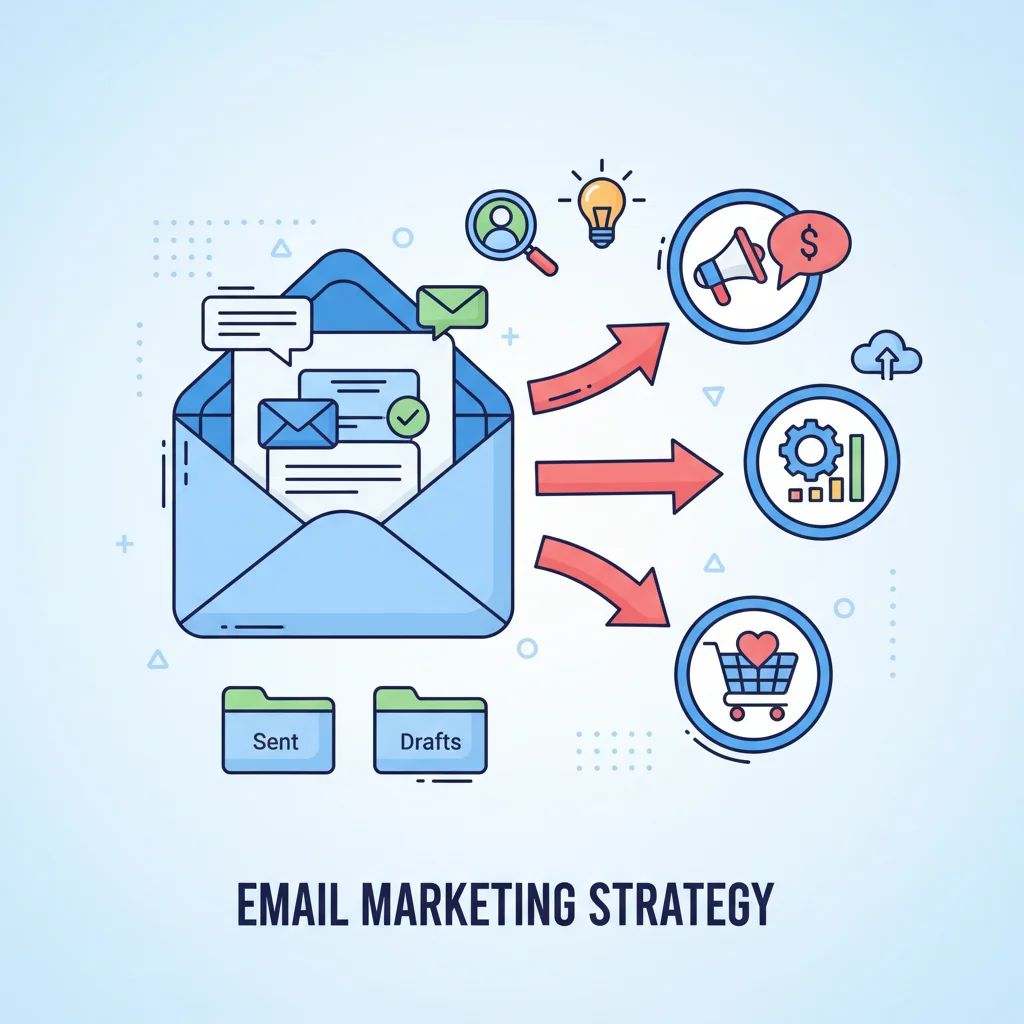Now Reading: Dynamic Content: The Secret Weapon in Email Marketing
-
01
Dynamic Content: The Secret Weapon in Email Marketing
Dynamic Content: The Secret Weapon in Email Marketing

Data doesn’t lie: personalized subject lines boost open rates by up to 50%. But dynamic content in email marketing goes way beyond just adding someone’s name. It’s about creating truly individualized experiences that speak directly to each subscriber’s interests, behaviors, and needs. In today’s crowded inbox, this level of personalization isn’t just nice to have-it’s essential for standing out and driving results.
Key Takeaways
- Dynamic content in email marketing automatically personalizes elements (subject lines, images, text, CTAs) based on subscriber data and behavior
- Start with audience segmentation using demographics, location, and behavior data to create targeted content variations
- Implement dynamic content in high-impact areas first: subject lines, product recommendations, and personalized greetings
- Use behavioral triggers like abandoned carts or browsing history to send timely, relevant dynamic emails
- Follow best practices: test different variations, avoid over-personalization, ensure mobile responsiveness, and maintain consistent branding
What Is Dynamic Content In Email Marketing?
Let’s break this down in simple terms. Dynamic content in email marketing is like having a chameleon in your marketing toolkit-it changes based on who’s looking at it. Instead of sending the exact same email to everyone, dynamic content automatically customizes specific elements for each recipient based on data you’ve collected about them.
Think of it this way: when you walk into your favorite coffee shop and the barista remembers your usual order, it feels good, right? Dynamic email content creates that same personalized feeling at scale.
The beauty is that you only need to create one email template, but each subscriber receives a version tailored to their:
- Demographics (age, gender, location)
- Past purchases or browsing history
- Engagement level with your brand
- Position in the customer journey
- Personal preferences and interests
For example, a clothing retailer might show women’s products to female subscribers and men’s products to male subscribers-all from the same email campaign. Or a restaurant chain could display different location-specific offers based on where each subscriber lives.
This isn’t just adding someone’s first name to an email (though that’s a start). We’re talking about swapping out entire sections of content, images, offers, and even CTAs to match what each person cares about most.
Useful Articles:
Why Dynamic Content Matters For Your Emails
I’m gonna be honest-static, one-size-fits-all emails just don’t cut it anymore. Your subscribers are drowning in generic marketing messages every day. Dynamic content helps you stand out in crowded inboxes by making your emails relevant to each recipient.
The benefits are pretty impressive:
Enhanced Personalization
Basic personalization (like adding someone’s name) is good, but dynamic content takes it to a whole new level. It creates truly individualized experiences that make subscribers feel understood. When you show people content that aligns with their specific interests and needs, they’re more likely to engage with your brand.
Better Engagement Metrics
The numbers speak for themselves. Personalized subject lines can boost open rates by up to 50%. And when the email content itself is dynamically tailored, click-through rates typically soar because people are seeing stuff they actually care about.
Higher Conversion Rates
When you show the right products, offers, or content to the right people at the right time, conversions naturally follow. Dynamic content helps move customers down the funnel more effectively by displaying what’s most relevant to their current situation.
Real-Time Relevance
Unlike static content, dynamic elements can update in real-time. This means your emails can include current inventory levels, countdown timers for sales, or updated event information-creating urgency and encouraging immediate action.
Efficient Marketing
Instead of creating multiple separate campaigns for different audience segments, you can build one template with dynamic elements that adapt to each recipient. This saves time while delivering better results-a win-win for busy marketers.
Types Of Dynamic Content You Can Use
There are tons of ways to incorporate dynamic content into your emails. Let’s look at the most effective types:
Subject Lines
This is probably the easiest place to start with dynamic content. Personalizing subject lines with the recipient’s name, location, or interests can significantly boost open rates.
For example, instead of “New Products Available,” you could use: “Sarah, New Hiking Gear Just Arrived in Seattle!”
The dynamic elements here are the name and location, which would change for each recipient based on their data. According to research, personalized subject lines can increase open rates by up to 50%.
Personalized Text and Messaging
Dynamic content can customize various text elements within your email:
- Greetings that include the recipient’s name
- References to past purchases or interactions
- Location-specific information
- Content based on interests or demographics
For instance, an email might reference a subscriber’s recent purchase: “How are you enjoying your new Canon camera? Here are some accessories that pair perfectly with it.”
Custom Visual Elements
Images and videos have a huge impact on engagement. With dynamic content, you can display different visuals based on subscriber data:
- Product images tailored to interests or past purchases
- Gender-specific imagery
- Age-appropriate visuals
- Location-relevant scenes
Research shows that when viewing text and visuals together, 65% of people remember the content after 72 hours, compared to just 10% for text alone.
Dynamic CTAs (Calls to Action)
Different subscribers might be at different stages in their customer journey. Dynamic CTAs can address this by showing:
- “Learn More” buttons for new subscribers
- “Shop Now” for engaged browsers
- “Reorder” for repeat customers
- “Upgrade” for basic-tier users
Product Recommendations
This is where e-commerce brands can really shine. Dynamic product recommendations can be based on:
- Browsing history
- Past purchases
- Abandoned cart items
- Complementary products
- Seasonal relevance
Location-Based Content
Geo-targeting allows you to customize content based on where your subscribers are located:
- Local store information
- Regional promotions or events
- Weather-appropriate products
- Location-specific shipping details
Behavioral Triggers
Some of the most effective dynamic emails are triggered by specific user behaviors:
- Abandoned cart reminders
- Browse abandonment follow-ups
- Post-purchase recommendations
- Milestone celebrations (anniversaries, birthdays)
Useful Articles:
How To Implement Dynamic Content In Your Emails
Now that you understand the what and why, let’s get into the how. Here’s a step-by-step approach to adding dynamic content to your email marketing:
1. Collect And Organize Your Data
Dynamic content is only as good as the data that powers it. Start by collecting and organizing relevant information about your subscribers:
- Basic demographics (name, age, gender, location)
- Purchase history
- Website browsing behavior
- Email engagement metrics
- Preferences and interests
Most of this can be gathered through:
- Sign-up forms
- Website tracking
- Purchase data
- Surveys and preference centers
- Email engagement analytics
Pro tip: Don’t try to collect everything at once. Start with the most important data points and expand over time.
2. Segment Your Audience
Before diving into complex dynamic content, start by segmenting your audience into logical groups. This helps you understand what content variations you’ll need to create.
Common segmentation approaches include:
- Demographics (age, gender, income level)
- Geographic location
- Purchase history
- Engagement level (active vs. inactive)
- Position in the customer journey (new subscriber, first-time buyer, loyal customer)
For example, a fitness brand might segment their audience by fitness level (beginner, intermediate, advanced) and workout preferences (yoga, strength training, running).
3. Choose The Right Email Marketing Platform
Not all email platforms offer the same dynamic content capabilities. Look for one that supports:
- Easy-to-use dynamic content tools
- Robust segmentation features
- Integration with your CRM and other data sources
- A/B testing capabilities
- Analytics to measure performance
Popular platforms with good dynamic content features include Mailchimp, Brevo, Constant Contact, and Adobe Marketo Engage.
4. Start With Simple Dynamic Elements
Don’t try to make everything dynamic at once. Begin with high-impact, easy-to-implement elements:
- Personalized subject lines
- First-name greetings
- Location-specific references
- Basic product recommendations
As you get comfortable, you can add more complex dynamic content blocks.
5. Create Your Dynamic Content Blocks
Most email platforms use a template system with conditional logic or “if/then” rules to display different content to different segments.
For example:
- IF subscriber is female, THEN show women’s products
- IF subscriber is in New York, THEN show New York store information
- IF subscriber has purchased Product A, THEN show complementary Products B and C
Some platforms use a more advanced system called “merge tags” or “liquid templating language” to insert dynamic content.
6. Test Before Sending
Always preview and test your dynamic content before launching a campaign:
- Send test emails to yourself representing different segments
- Check how the email renders on different devices
- Verify that the dynamic content is displaying correctly
- Have team members review for any errors or issues
Remember that dynamic emails are more complex than static ones, so thorough testing is crucial.
Best Practices For Dynamic Email Content
To get the most out of dynamic content, follow these proven best practices:
Focus On Relevance, Not Just Personalization
Don’t use dynamic content just because you can. Every personalized element should serve a purpose and add value for the recipient. Ask yourself: “Does this customization make the email more relevant and useful for the subscriber?”
Maintain Consistent Branding
While content may change dynamically, your brand voice, visual identity, and overall message should remain consistent. This ensures subscribers still recognize your emails regardless of the dynamic elements.
Avoid Over-Personalization
There’s a fine line between helpful personalization and being creepy. Avoid referencing too much personal data or information that subscribers might not realize you have. Focus on using data in ways that feel helpful rather than intrusive.
Ensure Mobile Responsiveness
With over 60% of emails opened on mobile devices, make sure your dynamic content looks good on small screens. Test how images resize, how text flows, and how the overall layout adapts to mobile viewing.
Use Default Content As Fallbacks
Always have default content ready for cases where you don’t have the necessary data for personalization. This ensures everyone receives a complete, professional-looking email even if you’re missing some of their information.
Test Different Variations
A/B test different approaches to dynamic content to see what resonates best with your audience. Try varying:
- The types of dynamic content you use
- How much personalization to include
- Different ways of presenting recommendations
- Various dynamic subject line formats
Keep It Simple (At First)
Start with one or two dynamic elements per email and gradually increase complexity as you become more comfortable with the technology and see positive results.
Useful Articles:
Powerful Examples Of Dynamic Content In Action
Let’s look at some real-world applications of dynamic content that you can adapt for your own email marketing:
Abandoned Cart Emails
These emails dynamically display the exact products a customer left in their cart, often with a time-limited discount to encourage completion of the purchase.
What makes it effective:
- Shows the specific items the customer was interested in
- Creates urgency with countdown timers
- Often includes personalized product recommendations
- May offer a dynamic discount based on cart value
Location-Based Promotions
Retail brands with multiple locations can send emails promoting events or sales at the store closest to each recipient.
For example, a restaurant chain might send:
- To New York subscribers: “Join us this weekend at our Manhattan location for live music!”
- To Chicago subscribers: “Visit our Chicago restaurant for our new seasonal menu!”
The email template is the same, but the location details change dynamically.
Behavioral Trigger Emails
These are sent based on specific user actions and contain dynamic content relevant to that behavior.
For instance, after browsing a particular category on your website, a subscriber might receive an email showcasing the top products from that category with personalized recommendations.
Milestone Celebration Emails
These emails recognize important customer milestones with dynamic content tailored to their relationship with your brand.
Examples include:
- Anniversary emails (“It’s been 1 year since you joined us!”)
- Birthday emails with special offers
- Purchase milestone emails (“Congratulations on your 10th order!”)
Weather-Based Recommendations
For businesses affected by seasonal changes, dynamic content can adjust based on the current or forecasted weather in the recipient’s location.
A clothing retailer might show:
- Rain gear to subscribers in rainy locations
- Sun protection to those in sunny areas
- Winter coats to people experiencing cold weather
Technical Implementation Of Dynamic Content
Let’s get a bit technical (but not too technical, I promise). Here are the main ways dynamic content gets implemented:
Merge Tags/Variables
The simplest form of dynamic content uses merge tags or variables that get replaced with subscriber-specific information when the email is sent.
For example:
Hello {{first_name}},
Thank you for your recent purchase of {{product_name}}.Would become:
Hello Sarah,
Thank you for your recent purchase of Wireless Headphones.Most email platforms support basic merge tags for simple personalization.
Conditional Content Blocks
More advanced dynamic content uses conditional logic to show or hide entire sections of an email based on subscriber attributes.
The basic structure looks like:
{% if subscriber.gender == 'female' %}
[Content for female subscribers]
{% else %}
[Content for male subscribers]
{% endif %}This approach allows for more sophisticated personalization than simple merge tags.
API Integrations
For the most advanced dynamic content, email platforms can pull real-time data from other systems via APIs:
- Current inventory levels from your e-commerce platform
- Account information from your CRM
- Real-time pricing from your product database
- Weather data from weather services
Dynamic Image Generation
Some specialized services can dynamically generate images personalized for each recipient. This might include:
- The recipient’s name visually incorporated into an image
- Countdown timers rendered as images
- Maps showing the nearest store location
- Personalized product recommendations displayed visually
Getting Started With Dynamic Content Today
Ready to dive in? Here’s a simple three-step plan to start implementing dynamic content in your email marketing:
Step 1: Audit Your Current Data
Take stock of what subscriber data you already have available:
- What fields are in your email database?
- What behavioral data are you tracking?
- How clean and accurate is your existing data?
- What additional data would be valuable to collect?
This audit will help you understand what types of dynamic content you can implement immediately versus what might require additional data collection.
Step 2: Start With One Dynamic Element
Choose one high-impact dynamic element to implement first:
- Personalized subject lines are an easy win
- Product recommendations based on past purchases
- Location-specific content if you have geographic data
- Behavioral triggers like abandoned cart emails
Master this single element before adding more complexity.
Step 3: Measure, Learn, And Expand
After implementing your first dynamic content element:
- Compare performance metrics to your static emails
- Gather feedback from subscribers if possible
- Identify what worked well and what could be improved
- Use these insights to guide your next dynamic content implementation
Remember, dynamic content is a journey, not a destination. Start simple, learn from each campaign, and gradually increase sophistication as you see positive results.
Dynamic content in email marketing isn’t just a fancy feature-it’s becoming the standard for effective email communication. By delivering personalized, relevant content to each subscriber, you create more engaging experiences that drive better results. Start small, focus on value, and watch your email performance soar as you master the art of dynamic content.





















